




By Essence Barnes STATESMAN REPORTER
As the United States Department of Education faces layoffs and President Donald Trump’s latest initiatives to dismantle the federal agency, students, staff and educators at Utah State University are left to speculate the future of DOE functions on college campuses.
While Trump’s recent executive order to abolish DOE and “move education into the states” must receive a pass from Congress to officially go into effect, roughly 50% of the workforce has already been fired, and the department’s core functions are said to be potentially redistributed under different government agencies if abolished. DOE is given roughly 4% of the annual federal budget to carry out its core functions. These functions include overseeing student financial aid and student loans, enforcing civil rights laws and equal access to education and funding research and data collection in American schools and institutions.
“Currently, Utah State University has more than $75 million in funding coming from the Department of Education with anticipated amounts to go up to 123 million based on our current awards,” said Lisa Berreau, USU Office of Research vice president.
According to Craig Whyte, executive director for USU Student Financial Support, the finance office hopes to offer students a website including information about DOE impacts on financial aid in the future.
“As it currently stands, federal student aid programs are still available to students,” Whyte wrote in an email to The Utah Statesman. “So we continue to encourage students to submit their 2025-2026 FAFSA, as well as any applications available within the USU Scholarship Portal.”
Funding from DOE is used to provide students with financial aid as well as to reinvest back into research and development grants, along with covering other institutional costs. Without a specific agency trained to handle these responsibilities in schools, the speed and efficiency at which federal funds are distributed is expected to suffer.
According to Berreau, USU’s anticipated $48 million budget increase could be impacted or delayed by recent DOE restructurings.
“If we take it to the federal level, I would say yes, I am deeply concerned that the amount of funding is going to be reduced overall,” Berreau said.
A decrease in federal funding for public schools could have complex implications on students’ abilities to apply for and receive financial aid from Pell Grants, federal student loans, work-study programs and FAFSA scholarships.
The U.S. secretary of education Linda McMahon has stressed financial aid money will not be affected by plans to downsize the DOE, but key staff members lost to the

layoffs and possible dismantling of the department could have butterfly effects on the speed and quality of student funding down the line.
Due to the uncertainty surrounding the future of federal funding for schools, USU’s finance office is still in the early days of determining exactly what these changes mean for student aid programs.
A decrease in federal funding could also lead to greater competition for remaining funding sources in the future.
“When one prepares a grant proposal for submission to the federal government, this is not something you do on a weekend or even in a week,” Berreau said. “The loss of funding and having to work even more on getting funding by, for example, submitting more applications is very time consuming and very hard work.”
According to Berreau, greater competition for funding resources could result in greater competition among students for research opportunities.
“We want to be a campus that has as many opportunities as possible for students to participate in research, and we understand the importance research can play in helping a student learn their craft,” Berreau said. “These kinds of reductions in funding are going to reduce opportunities. It’s almost guaranteed to happen.”
DOE is also responsible for enforcing discrimination laws like Title IX and Title VI in education, and these enforcements are suspected to weaken without direct federal government oversight.
While the Office of Equity did not respond to the Statesman’s request for a comment, as it stands, all discrimination laws are still enforced on USU campuses.
In response to these potential challenges, the Office of Research has been keeping students up to date on DOE changes through their website while also speaking with local state officials about their concerns.
“We are trying to make sure our elected representatives understand the impacts,” Berreau said. “We’re putting together information about what we’re seeing in regard to a reduction in available funding — for example, how that will affect our faculty and students.”
To stay up to date on the latest DOE news impacting USU campus, students and staff can visit research.usu. edu/government-updates.

Essence Barnes is a second-year student majoring in journalism and minoring in environmental studies. She enjoys reading, writing and caffeine.
— essence.barnes@usu.edu
By Emma Shelite STATESMAN REPORTER

Students may soon have 24/7 access to emergency contraception and other essential health items due to a student-led initiative aiming to install a pharmacy vending machine on campus. Backed by both local advocates and national momentum, the project seeks to reduce barriers to healthcare access and normalize reproductive health resources in higher education spaces.
The initiative is being driven by Students United for Reproductive Freedom in partnership with faculty members like Lu Lawrence and with inspiration and guidance from Jamie Maughan, University of Utah student and Women’s Health DNP candidate who is working to expand these vending machines across Utah campuses. Lawrence emphasized the overwhelming student support they’ve seen so far through a campus-wide survey.
“We had over 100 responses within the first few days,” Lawrence said. “Students clearly want more accessible, stigma-free options for healthcare, especially in moments of urgency.”
The vending machine would offer emergency contraception, commonly known as Plan B, along with affordable over-thecounter items like ibuprofen, cold medicine, menstrual products, condoms and lubricant. While similar items are available elsewhere, Maughan explained students in Cache Valley face unique challenges.
“Many local pharmacies keep emergency contraception behind the counter, which creates a barrier,” Maughan said. “A vending machine would offer a more private, convenient and affordable solution.”
Maughan, who learned about the vending machine model through the ASCENT Center Summer Institute, has been working to expand the concept to USU. Although she wasn’t involved in launching the machine at the U, her collaboration with the ASCENT Center and first-hand knowledge of its success has helped shape the vision for USU.
“We do anticipate pushback, but access to legal, FDA-approved products shouldn’t be controversial,” Maughan said. “It’s about health, privacy and equity.”
Nationally, over 110 universities across 27 states have already implemented similar vending machines. Illinois even passed a law in 2023 requiring emergency contraception be made available through vending machines on public college campuses. With multiple Utah campuses now exploring similar initiatives, USU advocates hope the university will follow suit.
“If approved, we could see this machine in place within a year,” Maughan said.
“We already have a model to follow — we just need institutional support.”
Students who wish to get involved are encouraged to participate in the ongoing survey that is accessible through posters around campus, join SURF or contact university administration to voice support.
— Lu Lawrence
The machine at the U has already distributed more than 2,000 doses of emergency contraception and led to the addition of a second, dorm-based machine for roundthe-clock access.
“This isn’t just about emergency contraception,” Lawrence noted. “It’s about broader access to healthcare products, especially for students who may not have reliable transportation or who face stigma when asking for these items in person.”
The project has received funding support from the Center for Intersectional Gender Studies and Research, and donated products from ASCENT will help stock the machine. Locations currently being considered include the TSC and the Student Health and Wellness Center.
Still, both Lawrence and Maughan acknowledge the cultural challenges of implementing such a resource in a traditionally conservative region.
“This machine would be a step toward inclusive, responsive healthcare access on campus,” Lawrence said. “It’s a conversation our students are clearly ready to have.

Emma Shelite is a junior pursuing a bachelor’s degree in communications and journalism. Her writing is fueled by Dr Pepper and an extroverted personality. Outside of the newsroom, she is passionate about cooking, athletics and her love for dogs. — emma.shelite@usu.eduu

By Bailey Daniels STATESMAN REPORTER
Just in time for Earth Day, Aggies and community members alike have another place to go thrift shopping in Cache Valley. A new EastersealsGoodwill Northern Rocky Mountain Inc., more commonly known as Goodwill, location opened in Logan on March 27 at 1618 N. Main Street. Located in what used to be Big Lots Furniture, the new Goodwill is a 10-minute walk from the Logan Deseret Industries Thrift Store & Donation Center.
On the day of the grand opening, there was a ribbon cutting ceremony with the Cache Valley Chamber of Commerce at 8:45 a.m., with doors officially opening at 9 a.m. The first 75 people through the door received a surprise gift. To promote the new location, five $100 Goodwill gift cards were given away to those who entered the drawing via their website at esgw.org. The winners were announced on March 31.
The store has been accepting donations since Feb. 28.
Donation hours are Monday through Friday from 9 a.m.–4 p.m. Items to donate consist of furniture, electronics, houseware and gently-used clothing.
Goodwill is a private and nonprofit organization. The money they make from the items donated to their stores goes toward causes such as serving individuals with disabilities and disadvantaged families. Chelle Fried is the current director of digital marketing and community relations.
“Our Goodwill stores will provide another opportunity for sustainability in the Logan community,” Fried wrote

in an email to The Utah Statesman. “When people donate their gently used items and purchase used items, they help their community not only by helping the environment, but by helping others.”
One of the ways the money the organization makes helps others is through the Senior Community Service Employment Program. The goal is to find employment for
low income individuals over the age of 55. Participants receive aid in job search skills like interviewing, creating resumes and job hunting. The company has been offering this program since 2008 throughout Utah, Montana and Idaho.
More options for shopping at nonprofit second-hand businesses in Logan may excite budget shoppers and vintage lovers alike. Somebody’s Attic is another nonprofit that donates 100% of its proceeds to local charities such as CAPSA.


Bailey Daniels is a studying technology systems. She loves Lana Del Rey, sweet treats and all things whimsical.
— bailey.daniels@usu.edu

March 12
Officers responded to a stray dog near the Poisonous Plant Research Laboratory. Officers were able to locate the animal, which was taken to the animal shelter for its safety.
March 13
K-9 Sage and Officer Shane Nebeker spent time with a Deseret News reporter and camera crew visiting several places on campus including the ARC, TSC, Huntsman Hall and the Quad.
March 19
There was a report of a suspicious odor at the Natural Resource Building. Responding officers determined the source of the odor was from fumes originating from construction in the building.
March 21
A traffic offense was reported at Aggie Village. Contact was made with the driver, who was advised to stop driving on sidewalks in the area.
March 22
Officers responded to an incident on Old Main Hill. There was a report of an officer door being plastered with flyers by unknown individuals.
By Alici Archibald STATESMAN REPORTER
The second annual President’s Forum on Conflict and Conflict Transformation, titled Navigating Political Polarization: A Call to Constitutional Action, featured Judge Thomas B. Griffith as keynote speaker.
Griffith’s lengthy experience includes serving as a federal judge on the United States Court of Appeals for the D.C. Circuit, chief legal officer of the U.S. Senate and a member of former President Joe Biden’s Presidential Commission on the Supreme Court. He is currently a lecturer on law at Harvard and Stanford law schools.
Griffith spoke about the “profound crisis” of political polarization in the United States. His speech focused on how the U.S. Constitution’s foundational principles of negotiation and compromise can provide pathways to address toxic polarization.
Griffith started his speech with some “bad news:” the United States is politically polarized in ways it has never been before. The difference in polarization today is based on what Griffith defines as affective polarization, where one’s hatred for the other side motivates their engagement.
Griffith clarified the issue is not disagreement.
“I’m an American. I disagree about everything, okay, and that’s good,” Griffith said.
The issue is contempt, which Griffith says is a “cancer.” Part of the issue comes from a media landscape that thrives on addiction to outrage. He identified problems with cable news, talk radio and social media.
“You’re being played. You know that, right? It’s being carefully curated,” he said.
Griffith offered three solutions to building trust in democracy and healing political polarization.
The first solution, which he deemed easy, is building trust in the election system. Griffith referenced an article he assisted in writing: a case called “Lost, Not Stolen: The Conservative Case that Trump Lost and Biden Won the 2020 Presidential Election.” Griffith told the audience that while not perfect, the U.S. election system is good.
The next solution he claimed is a little bit harder, which is building confidence in the judicial system. Griffith noted he served on the D.C. Circuit for 15 years.
“Never once did I see any one of them cast a vote that was in any way tainted by their partisan priors,” Griffith said.
The hardest one is the most important to Griffith: supporting the basic principles of the Constitution. Though protecting human rights is important, Griffith claimed the most important function of the Constitution precedes even that. He explained it teaches Americans how to create a structure of government that tells them how to work together when they disagree.

Griffith spoke about the events at the Constitutional Convention in Philadelphia. He said compromises must be made in order to build a country like this.
He claimed these changes must happen in the institutions of family, church and school.
“I wish it would come from our leaders, but I don’t think we can wait for that,” Griffith said.
Following Griffith’s speech was a panel featuring Lord Michael Hastings of the Stephen R. Covey Leadership Center Advisory Board and political science professor Jeannie Johnson. USU’s College of Humanities and Social Sciences Dean Joseph P. Ward moderated, asking questions submitted by audience members prior to the event.
When asked about political polarization, Johnson said it is important to understand issues are often not a matter of right versus wrong. When people seek to understand others, they see a wider picture of why others do the things they do.
“See decisions… as packages of trade-offs instead of along a moral scale,” Johnson said.
Hastings noted the world “needs people of huge intelligence and integrity, but we need them to be prepared to stand up and stand out.”
Griffith ended his thoughts by commenting on the need for these changes on college campuses.
“I think colleges and universities are the most important component,” Griffith said.
Johnson agreed and discussed her hope in Generation Z.
“They already do this really well… In some ways, the adults need to get out of the way,” she said.
Johnson said she believes Gen Z can help bridge the divide, but only if they make the effort to do so.
“They’re there. They’re interested in behaving this way… we just need to give them the room to express it,” Johnson said.

Alici Archibald is a junior studying journalism who loves all things related to news. You may spot her playing the trumpet in the Aggie Marching and Pep Bands, watching sport or listening to one of her many political podcasts.
— a.archibald@usu.edu
By Esther Owens STATESMAN REPORTER
The National Society of Leadership and Success, founded in 2001, aims to help students discover their leadership potential.
Utah State University started its NSLS chapter in 2016, and it is led by Jose Sandoval, who took office as president at the end of 2024. He has been involved with NSLS since 2023, originally as a member.
“The chapter has been here on campus since 2016, but I don’t know what happened between 2016 to when I
took office because I’ve had to build everything from scratch,” Sandoval said. “It was a bit of a challenge, especially finding an adviser.”
Sandoval hopes to provide more visibility to the chapter itself and address the disconnect between students who are nominated and students who complete the entire process.
“To have 1,000-something students and only 600 that actually made it through the whole program — there had to be some type of challenge that kind of interfered with people not completing,” Sandoval said.

Students are invited to join the honor society based on criteria involving GPA. They then undergo a four-step induction process to become a member.
In the first step, students are given an introduction to the history of the NSLS and expectations of the program. The second step focuses on helping students understand their personal leadership style and how to use it when working with a team.
“My intent is to create a workshop and develop something that’s going to actually get students to think, ‘Okay, let me actually understand myself respectively and how I can manage that aspect of myself as a leader and continue to develop myself and those skills,’” Sandoval said.
The third step is a broadcast of guest speakers such as public figures who demon -
strate leadership qualities, followed by the final step that focuses on goal setting.
“The fourth step is what we call ‘success networking teams,’” Sandoval said. “It’s basically setting goals for about three weeks where you meet with this specific group that’s helping you get through those steps of completing a goal that you had in mind.”
Goal setting is a foundational aspect of NSLS membership and a large part of the induction process. Students can set goals to meet their personal needs and don’t have to be professional or academic-oriented.
“My vision is to provide resources to students and get them involved,” Sandoval said. “Provide them with opportunities to step into that relationship — doing things that are going to make a difference.”


Esther Owens is a sophomore studying journalism. When she’s not busy working on a story, you can find her at the climbing wall.
— esther.owens@usu.edu
The Sundance Institute has announced that the 2027 festival will be held in Boulder, Colorado, making the 2026 festival the last in Park City, for now.
As written on the Sundance Institute’s website, “We envision the heart of the Festival centered in downtown Boulder, utilizing a wide array of theaters and venues, and incorporating spaces around the Pearl Street Mall, a pedestrian-only street. Nearby spaces will offer dedicated locations for our community to gather, including select spots on the nearby University of Colorado (CU) Boulder campus.”
There were two other finalist cities for the festival, one being Cincinnati, Ohio and the other being Park City. “This decision was informed by a detailed evaluation of the key components essential to creating our festival. During the process, it became clear that Boulder is the ideal location in which to build our festival’s future, marking a key strategic step in its natural evolution,” said Ebs Burnough, Sundance Institute board chair.
Park City has been the host of the festival for the past 40 years, and the city has voiced they are proud of the work done by the Utah Bid Committee in their attempts to keep the festival in Utah.
“Frankly, I don’t know if there is anything else we could have done,” wrote Park City Mayor Nann Worel in an official statement. “Sundance’s departure marks the end of an incredible era, but not the end of Park City’s magic.”
Colorado Gov. Jared Polis shared his excitement for bringing the festival to Colorado.
“Here in our state, we celebrate the arts and film industry as a key economic driver, job creator and important contributor to our thriving culture. Now, with the addition of the iconic Sundance Film Festival, we can expect even more jobs, a huge benefit for our small businesses, including stores and restaurants,” Polis said.
At the time of publication, it is unclear how many years the festival is to remain in Boulder.

By Brook Wood STATESMAN REPORTER
Students and alumni gathered for an evening of connection and exploration at the College of Humanities and Social Sciences Networking Night.
Brittney Skye, alumni program coordinator for CHaSS, was in charge of organizing the event and tried to cover as many departments as possible.
“CHaSS is a huge college, and our students are all the way from our ROTC cadets to archaeologists to English teaching students,” Skye said. “The stars don’t always align in that I’m able to bring in an alumni who matches up with every single major in our college, but I do also consider in addition to the alumni what fields they’re working in and what industry they are a part of.”
The event was a great success, according to Skye. Students who RSVP’d were seated with alumni who aligned with their interests, and because the event was only at 80–90% capacity, staff was able to allow walk-ins.
“Alumni got sick and had to cancel at the last minute,” Skye said. “One had an unexpected work trip come up, but luckily, because I had enough alumni who had a lot of crossover with each other, I was able to just kind of rearrange some of the seating charts.”
Despite having to shuffle alumni and students around last-minute, Skye said people remained in deep discussion even as dessert was served, and mingling was encouraged.
“They wanted to stay right where they were, which I think is a fantastic sign of a successful alumni-student interaction,” Skye said.
Skye highlighted how alumni were excited for the event and were eager to talk about their journeys and what they’re passionate about.
“I think they were more excited when they left than when they arrived because they weren’t really sure how the night was going to go — if you’re going to have a talking table or a silent table,” Skye said. “But everyone seemed to really enjoy themselves.”
CHaSS peer advisers volunteered at the event, including anthropology major Sascha Baldauf and political science major McKenzie Campbell.
“It kind of exceeded my expectations,” Baldauf said. “There were question prompts on the table, and the food was a lot better than I was expecting, and it wasn’t as awkward to talk to alumni, which I thought it would be.”
Baldauf and Campbell — along with other CHaSS advising students — arrived an hour early to set up and helped keep the event running smoothly by manning the check-in table, getting students their nametags and directing them to their respective seats.
“There were a lot more people than I thought there would be,” Campbell said. “I’ve been to this event before, but I felt like it was — it felt like there were more people this time.”


Brook Wood is working towards receiving a bachelor’s degree in literature. When they aren’t writing or reading, they enjoy playing the violin in the USU Symphony Orchestra and the occasional sweet treat.
— b.wood@usu.edu
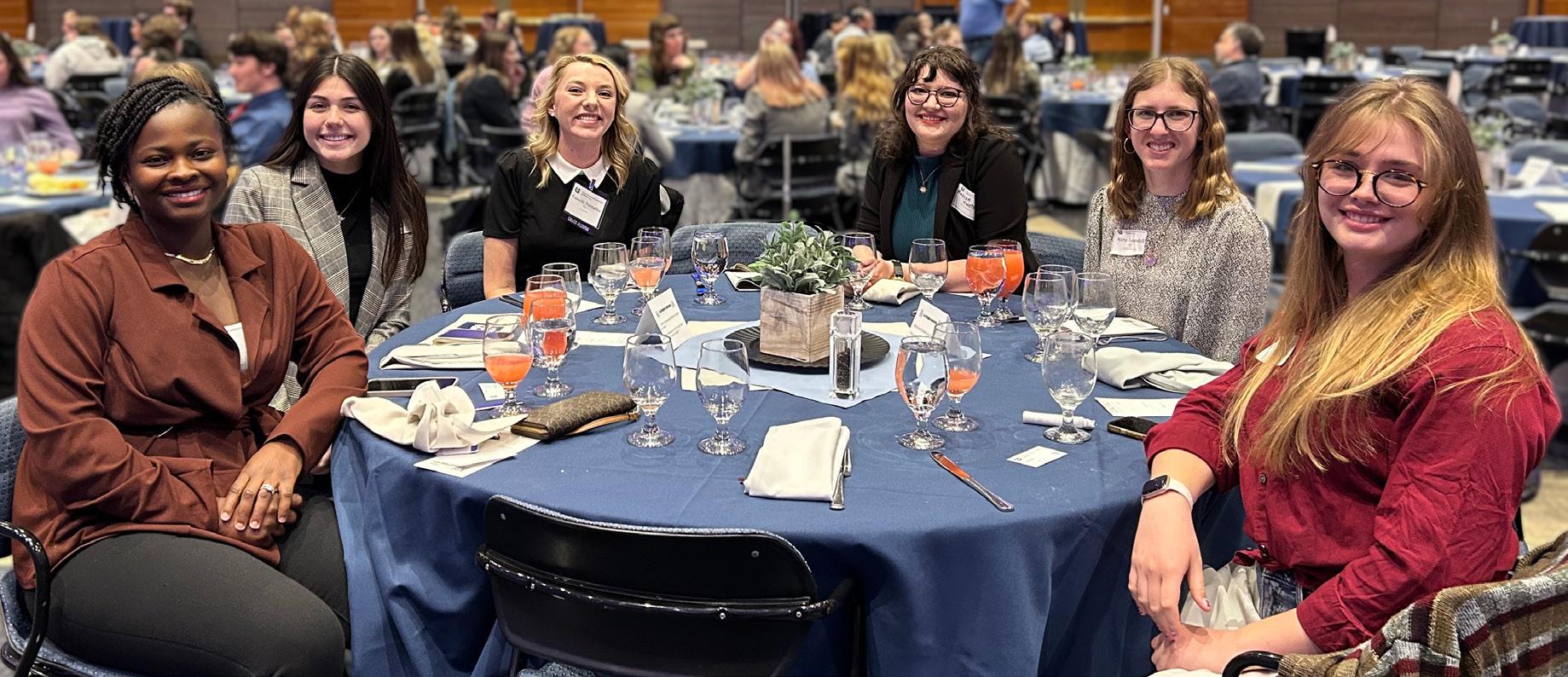


Looking for a show with new vibes every week and maybe a little more?
“Morten’s Corner,” every Friday from 10-11 a.m., has got a little bit of everything for everyone, including chances for listeners to participate.











By Lacey Cintron STATESMAN REPORTER
Since its origins in the early to mid-1980s, indie rock has given way to a variety of subtypes, each with its own unique spin on an already diverse genre. Some of the most popular include shoegaze and slowcore — two subgenres which are the bread and butter for local indie rock band dustdust.
“Nicole and I are partners who have been playing music together for a while, and we were working on another project when we had the idea for dustdust,” said Miles Folsom, who does vocals and plays guitar for the band.
“The name comes from scripture: ‘For you are dust, and to dust you shall return,’” said Nicole Steinicke, who provides vocals and synth.
Dustdust began with Folsom and Steinicke, but the duo soon realized the band needed something more to capture their sound. Now the band comprises four members, adding Misael Villanueva on bass and Alex Schneider on drums.
“We started writing music together — wrote a song or two — then it became pretty clear that we did want a rhythm section, a drummer and a bass player,” Folsom said. “So, I rounded up Misael and Alex, who are really amazing at what they do.”
While sub-genres of indie rock can include a variety of instruments from the synth to the violin, most include a guitar, vocals, drum and bass.
“I started to play guitar when I was 12, and after a year, I decided I wanted something more loud — something more groovy,” Villanueva said. “I started to play bass, and I got really into it because I saw parts of myself that I didn’t see before.”
According to Villanueva, the bass is an important element of any rock-derived song, acting as the rhythmic foundation for the other instruments.
“Misael is a great bass player for the band because he’s got that aggressive, punchy kind of bass sound, and he’s
good at locking in with Alex on that tight, punchy rhythm section,” Folsom said.
Vocals are another key aspect, giving voice to the song’s inherent message and tone.
“More than any of us, I think Nicole gives an identity to the band,” Schneider said. “I really think people have shaped the identity of the band around Nicole’s voice.”
The band hopes to characterize Logan’s indie music scene with the lesser-known stylings of rock.
“We wanted dustdust to be a little bit darker, a little more heavier,” Folsom said. “We wanted to incorporate some post-rock, shoegaze and slowcore and just do something that I don’t think is being done around here.”
Post-rock is an offshoot of rock music that places greater emphasis on the texture and atmosphere of a song while still utilizing the powerful sound of traditional rock instruments like guitar, bass and drums. The core principle behind indie rock and its subgenres is creative freedom and the ability to manipulate the elements of traditional rock.
“I like shoegaze because of the textures,” Folsom said. “It’s fun to incorporate noise in pretty ways. I like slowcore because slower music just speaks to my soul, and then post-rock is just a cool genre because you can do whatever you want as far as structures go.”
Shoegaze and slowcore take a more melancholy, dreamlike approach to the overall feel of the song, emphasizing droning riffs, blurry vocals and guitar distortion.
“It’s pretty common for slowcore artists to open for metal artists because it’s an extremity,” Steinicke said. “Slowcore demands more of yourself because of how slow you’re playing, the repetitiveness and being willing to sit with something for a long time.”
Shoegaze emerged in the late 1980s among Irish and British neo-psychedelic groups, deriving its name from performers who were often “shoegazing” because of heavy effects pedal usage. By the ‘90s, the genre was in its heyday with defining bands like My Bloody Valentine and Slowdive.

“A lot of what drew me to shoegaze has to do with having an older brother who grew up in the ‘90s, and he was into a lot of metal and post-metal music,” Schneider said. “I sense a lot of that in what we’re doing, so for me, it feels like it connects me back to my brother when we’re working on this music.”
On Aug. 23, the band released its first single: “Vision.” The song pays homage to its shoegaze roots in soft vocals that fade into the steady beat of drums and guitar melodies, interspersed by overwhelming choruses of sound.
“All of our stuff is fully recorded and produced ourselves. I mix and master it,” Folsom said. “It’s our own labor of love. The whole EP was recorded in one 15-hour day.”
The band has performed at several venues around Utah, including Logan’s WhySound and The Boiler Room in Ogden. The opportunity to share different styles of music and drive home a message is a key motivator for the band.




Lacey Cintron is majoring in psychology. She loves learning about the human mind, sharing stories and naps. — lacey.cintron@usu.edu
By Samantha Isaacson STATESMAN REPORTER
On March 19, the Logan Yes In My Back Yard, also known as YIMBY, hosted an event at Utah State University to discuss how to expand housing in Cache Valley and throughout Utah.
YIMBY refers to a pro-housing movement that focuses on accessible housing and policy reform.
Josh Smith, Logan chapter lead, said one of the main goals of this event was to get more students involved with the movement.
“I’ve been to a lot of city council meetings, and I’ve been involved in a lot of things, like listening to the planning commission that decides what gets built,” Smith said. “One thing I have noticed missing is students at these meetings. Housing developments are being denied because people are showing up to the city meetings to protest them. Students are a big group that resides within Logan, and they are not being heard right now.”
Megan Jenkins, another chapter lead, said the attendees of most city council meetings are usually older homeowners. Logan YIMBY is hoping to amplify the voices of the student community by educating them on what they can do.
“Young people in Cache Valley are disproportionately impacted by this housing shortage and the high housing costs we are experiencing,” Jenkins said. “We wanted to speak with them about the kind of policy that’s driving those costs and encourage them to talk to their local elected officials and express that they want policies that can help fix it.”
Karina Brown, policy analyst for the Cache County Executive Office, said if students begin to participate in the housing discussion, the community should see a big difference.
“We really want students to engage in the housing discussion by sharing insights and needs,” Brown said. “It will really help create a more balanced perspective.”
Gretchen Fairchild, senior in the nursing program at USU, said she is unhappy with the housing options avail-
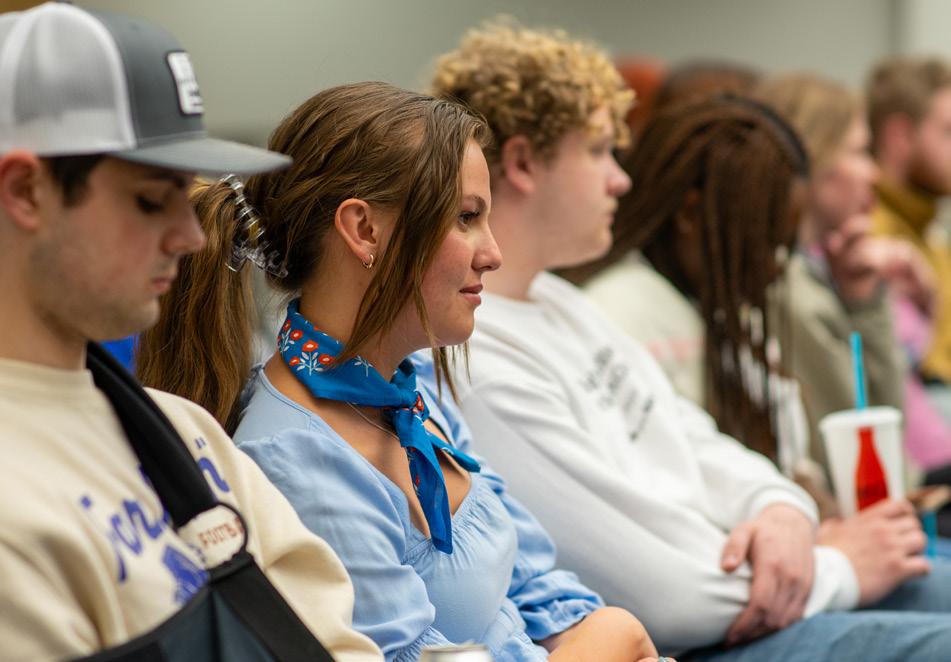
able to her as well as the price she is forced to pay because of the shortage of student housing.
“A lot of the housing in Cache Valley is severely overpriced, and most of the time, the quality of it is subpar at best,” Fairchild said. “Me and a lot of my friends have experienced the worst of housing, paying prices upwards of $600–800 a month and having many issues with appliances in our house as well as mold.”
Jenkins said one of the issues discussed was the high housing costs in Cache Valley.
“The reason for those high housing costs is that landuse regulations increasingly limit property rights,” Jenkins said. “The more limited those property rights are, the harder it is for people to build new housing.”
Smith said in the last few years, the housing prices in Utah have skyrocketed.
“Housing is a fundamental challenge in Utah right now,” Smith said. “With the continually increasing cost of housing, we are seeing more and more people who are put in a fragile situation and have to live paycheck to paycheck.”
Smith said one of the ways they are trying to make housing more affordable is through their “room for one more” movement.
“Logan City only allows three unrelated people to live together in a house regardless of how many bedrooms the house has,” Smith said. “Since Logan is a university town, this can make it a lot harder for students to be able to rent homes.”
Smith said if they are able to get the policy approved, it will allow four unrelated people to live in a home together. This will create more housing for students in Logan at a more affordable price.
Jenkins said along with needing more housing, more diverse types are needed.
“We don’t want to just have single family homes being built but also apartments, townhomes and other types,” Jenkins said. “You need a different type of housing from the time when you go to school to the time you retire.”
Brown said it is important for the students to realize they can make a big difference
“Students at USU and young people in Cache Valley need to realize that your voice matters, your perspective matters and what you say and do makes a difference,” Brown said.
Those who want to get involved with Logan YIMBY can visit loganyimby.org or contact them at hello@loganyimby.org.

Samantha Isaacson is a senior majoring in journalism with a double minor in art and psychology. She loves to read and spend time outdoors.
— sam.isaacson@usu.edu

By Ashley Dorius STATESMAN REPORTER
After winning their first-ever Mountain West Championship, Utah State University’s gymnastics was selected to compete in the NCAA Utah regionals on March 24. Regionals will be hosted by the University of Utah on April 2–5 at the Jon M. Huntsman Center and streamed live on ESPN+. This was the team’s first selection to compete in regionals since 2022.
“Incredibly proud of our athletes,” said Kristin White, gymnastics head coach. “This was our goal since last March: to get the whole team to regionals. Really excited to go compete against BYU. Our gymnasts want to get past the first round. They want to go to round two, and I truly believe that this team believes in their potential, and they are going to maximize every opportunity they are given.”
The press release states, “Utah State will face BYU in the first round on Wednesday, April 2, at 2 p.m.
The winner will advance to the second session of the second round on Thursday, April 3, at 7 p.m., and compete against No. 4 Utah, No. 14 Stanford and No. 18 Denver. The first session of the second round on Wednesday will feature No. 5 UCLA, No. 12 Minnesota, No. 23 Southern Utah and No. 30 Boise State. The top two teams from each session will advance to the third
round, which will be held on Saturday, April 5, at 5 p.m.”
Prior to the selection, on March 22, the team received a 196.100 at Provident Credit Union Event Center in San Jose, California, securing the win in the Mountain West. It is USU’s seventh conference title and first since the 2022 Mountain Rim Gymnastics Conference Championship.
Graduate student Brianna Brooks was named Championship MVP, tying for first on bars and third on beam.
Brooks qualified for the NCAA regionals on bars and beam, along with junior Avery Bibbey on bars, sophomore Sydney Jelen on beam and sophomore Nyla Morabito on vault and floor. The press release said Brooks, Bibbey and Jelen will compete in the second session no matter the team’s outcome versus BYU. Morabito will not compete due to a season-ending injury.
“Usually, when you see a whole team qualifying and are in that first round, you are typically going to have quite a few individuals that are going to make it to the second round,” White said. “So, incredibly proud of all the efforts of our student-athletes. Without their dedication, we wouldn’t be able to get there this year, so really excited to compete.”

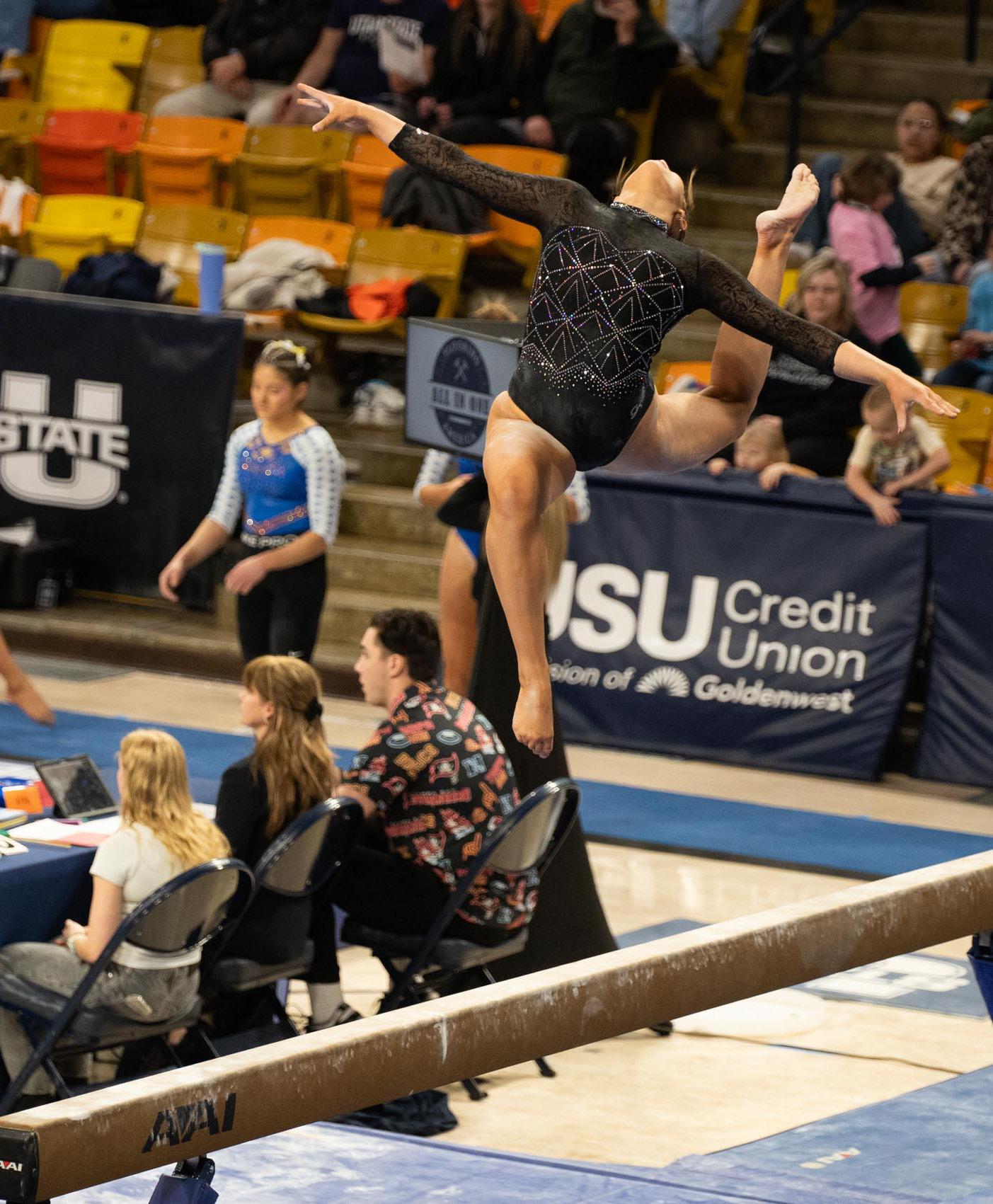
The Aggies are competing in their 28th regional. USU’s best finish at regionals was third in 1999 when it hosted Georgia, Florida, Denver, Minnesota and Iowa State. Utah State and BYU are tied, each ranked No. 32 in the nation with a National Qualifying Score of 196.025. In their last matchup, USU won with a 196.000 score over BYU’s 195.750 at the 2025 Les Olson IT Best of Utah NCAA Gymnastics Meet. Brooks said the Aggies are ready to take on the Cougars again.
“It has been a long time coming,” Brooks said. “It is much more fun when you can have your team support there, and I am really proud of this team, so I can’t wait to compete with them. We are excited to go back down to Salt Lake City. It is close to home for us, and our fans can come with us. We are excited about that and ready to compete against the Cougars.”

Ashley Dorius is a sophomore studying journalism. She would like to thank red nail polish, horror movie nights with roommates and Cane’s sauce.
— ashley.dorius@usu.edu
By Carson Frost STATESMAN REPORTER
In Wesley Brooks’ first year as the head coach of Utah State Women’s Basketball, the challenges were immense, but the vision remained clear. Stepping into a program in need of a rebuild, he knew success wouldn’t come overnight. Yet, despite the team’s struggles in the win-loss column, the signs of growth were undeniable, according to Brooks.
“You just never know what you’re getting into when you sign up for what you signed up for,” he said. “You knew it was going to be a rebuild, but overall, I think we got the most out of what we could with what we had.”
Brooks had a season of successes, according to his profile on the USU Athletics website.
“In Brooks’ first season at USU, the Aggies set a program record with 256 made 3-pointers. Utah State also surpassed the program record for 3-point attempts with 889 attempts from behind the arc on the year,” the profile said. “Brooks helped freshmen Carlie Latta and Taliyah Logwood to Freshman of the Week honors from the Mountain West, the first weekly conference honors for the team since 2022. Under Brooks’ stewardship, the Aggies saw year-over-year improvements that ranked among the top in the nation for 3-pointers made and attempted per game and finished the season at 4-27, earning a 10-seed in the MW Tournament.”
This is Brooks’ first full year of recruiting and navigating the transfer portal. He’s developed his own performance metric, rating teams and players on a scale from 0–100, akin to the player ratings used in video games “Madden NFL” or “NBA 2K.”
When he analyzed his ratings for his team last year, the data showed tangible improvement, according to Brooks. Aggie players who began the season rated in the 30s and 40s climbed into the 50s and 60s by season’s end.
Brooks said his crowning achievement in player development so far may have been the growth of Cheyenne Stubbs, who ended her college career on a scoring tear, averaging 21.9 points per game over her final eight games. “She was tremendous,” he said. “Even in her last game, a five-foot-six guard grabbing 14 rebounds and scoring 21 points — insane.”
Now, Cheyenne is preparing for a professional career, and agents are taking notice of her talent.
After years of experience as an assistant coach across multiple top women’s programs, Brooks stepped into the head coaching role facing new challenges.
“Everything’s your fault,” Brooks said. “Even if it’s not, it is. That’s the reality of being a head coach.”
The responsibility of shaping a program from the ground up is immense, but Brooks said it’s a challenge that fuels him.
“You move over six inches, and it’s a different world,” he said, referring to the shift from assistant to head coach.
As Utah State moves forward, the focus turns to the future, and that future includes a promising freshman class. With recruits like Aitana Rosello Lopez, Paloma Muñoz and Bella Cosme joining the fold, the emphasis has been on shooting and pace.
“We prioritize skill. You have to have a high skill level to play for us,” Brooks said. “And you have to be able to run.”
Lopez has played three-on-three with the Spanish national team, and Muñoz has already faced grown women in professional settings overseas. Their readiness to contribute at a high level could accelerate the program’s competitiveness, according to Brooks.
The transfer portal has become an essential tool in college basketball, and Utah State is actively seeking ways to bridge the talent gap.
Brooks used his ratings system to measure the Aggies’ performance last year, and the numbers are telling. While Utah State’s roster had an average rating of 47.5, conference leaders such as UNLV sat at 72.5.
To close that gap, the program is focusing on fundraising for NIL opportunities.
“If you go into the portal, you have to be prepared to spend money,” Brooks said. “We’re working hard on that.”
The goal is to secure top-tier talent while ensuring players have an opportunity to develop their careers both at Utah State and beyond.
Leading a women’s program that has seldom seen success, Brooks relishes the chance to make history.
“I think I’m a fire-starter,” he said. “I think I’m a leader. I think I’m a pioneer. I know what it’s like, and I know what it takes.”
Women’s basketball has never won their conference, let alone made the NCAA tournament. The program has only had six winning seasons over their 40-plus year history. That presents an opportunity for the current coaching staff to create something entirely new.
“We’re basically an expansion team,” Brooks said. “We’re building from the ground up. So, I think that’s the challenge and exciting thing.”
Investment in the program is key. While Utah State has long supported its men’s basketball and football programs, women’s basketball is beginning to receive the backing needed to compete at a higher level.
“You have to invest if you want to have a product that’s worthwhile,” he said. “I think now people are waking up.”
Beyond the court, Brooks has found a home in Logan. Assuming everything goes as planned, he envisions staying and building the program for the years ahead.
Brooks’ daughter, just two years old, is already an Aggie fan, joining in “The Scotsman” with pride.
“If she’s happy and loving it, then we have to be happy and loving it,” he said.
The journey ahead is daunting for the young head coach, but for women’s basketball, the support from fans and the community continues to grow.
With a committed coaching staff, an influx of fresh talent and a fanbase rallying behind them, the foundation is set for a new era of success, according to Brooks.


Carson Frost is a transfer student from Denver studying journalism. His family originally hails from Los Angeles, and he is a passionate fan of the Lakers, Dodgers and Philadelphia Eagles. He loves writing, making music, hitting the gym and taking road trips.
— carson.frost@usu.edu

By Landri LaJeunesse STATESMAN REPORTER
For those of you who have been following along, welcome back to the blog. For those of you who don’t know me, my name is Landri, and I am a student reporter currently abroad in Vietnam studying peacebuilding, communication and the history of the Vietnam War. Each week, I have been sending dispatches back to Utah State about what I am learning and experiencing in my time away — anything from museum trips to food reviews.
This week, however, the topic is a little different than my usual updates, which is why I thought it was important to switch things up a bit for this installment. Today, I don’t want to talk about my days and my classes. I want to talk about Agent Orange.
In my time here, I have come to recognize Agent Orange as one of the most devastating legacies of the Vietnam War. Starting in 1961, the U.S. government authorized a military aerial operation called Operation Ranch Hand to deforest and defoliate the dense landscape of Vietnam. According to David Zierler, writer of the book “The Invention of Ecocide,” the purpose of the operation was to improve visibility, remove vegetation from routes and destroy enemy crops.
To complete the job, they chose to spray herbicides and chemicals throughout the country. These chemical deployments were given code names based on the color of their band on the storage drum. The initial drops of herbicides were purple and blue-striped drums, respectively called Agent Purple and Agent Blue.
Eventually, orange-striped drums of a new mixture would replace these defoliant agents in 1965 when it was found to be more effective. This mixture, Agent Orange, would ultimately account for 61% of the recorded herbicide use during the Vietnam War, based on a report from the National Library of Medicine. This was due, in part, to its toxicity. Just one application of Agent Orange killed entire mangrove forests, or coastal wetland trees, in weeks.
To this day, herbicides themselves have a wide application from farming and forest management to lawn care and common-weed removal. However, with the use of defoliants like Agent Orange, sharp lines were drawn between the use of agricultural herbicides and their application within chemical warfare.
As stated in William Buckingham’s report on Operation Ranch Hand, Agent Orange destroyed nearly 3.1 million hectares of tropical forests and mangroves by 1971. These landscapes are essential to the function of Vietnam’s ecosystems, and the damage done to them took decades to recover. In a paper from the Journal of Soil Science, studies also show certain substances dropped during the war can remain for decades, continuously harming the land. More importantly, they have continued to cause harm to the people of Vietnam. Agent Orange itself is a composition of different chemicals and chemical byproducts known as dioxins. At the time of the war, there was limited research on the health effects of dioxin, but it is now recognized that dioxins can cause various health problems such as birth defects, reproductive harm, cancer, diabetes, heart disease, Parkinson’s disease and neuropathy, as reported by the Cleveland Clinic.

Still today, the people of Vietnam face issues directly related to the 10 years of herbicidal spraying across the country during the war. The Socialist Republic of Vietnam Ministry of National Defence reports that an estimated 4.8 million Vietnamese have been exposed to dioxin, including 3 million to Agent Orange. Photos of children malformed since birth, women with peeling skin and men with disabilities caused by dioxin cover the internet under a single search term. Furthermore, poor communities are more likely to live in areas with minimal dioxin/Agent
Orange cleanup efforts, meaning they are less likely to have access to clean water and uncontaminated food, as noted in a San Jose State University Research Journal of Justice Studies and Forensic Science. These communities bear the greatest burden of toxicity and have the least access to healthcare and aid, not just concerning Agent Orange but also overall in the population.
These problems, along with uncertainties surrounding foreign aid within the U.S., leave the future of herbicidal cleanup operations for dioxins like Agent Orange unknown and the problems Vietnam faces underrepresented and unchanged.
The hardest part I think comes down to what we can do about it. As a student, oftentimes we feel powerless when it comes to making large, systemic changes. Still to this day, the U.S. government has not taken responsibility for the effects of Agent Orange and dioxins, so future reparations have to start with me and you.
Moving forward, the United State’s ability to provide meaningful aid to those affected by Agent Orange, focusing on long-term cleanup efforts, healthcare access and financial support for affected families, will determine the relationship between our two countries. Only then can the legacy of Agent Orange be addressed in a way that ensures justice for the people still impacted by its devastating effects.
This solution rests on the willingness of all parties to confront the past and work toward an equitable and sustainable future, whatever that looks like. Today, it starts with a conversation. Tomorrow, this ongoing peacebuilding might begin with you.
For more information about Agent Orange or if you would like to contribute to an advocacy program, visit warlegacies.org or vietnamfriendship.org.

Landri LaJeunesse is a junior studying journalism and communications with a minor in yoga studies.
landri.lajeunesse@usu.edu
By Avery Truman STATESMAN REPORTER
ABBA has remained a band with top-notch music throughout the decades. From enjoying their music in “Mamma Mia!” to singing along in the car, I have always been drawn to their unique style.
Four Seasons Theatre Company is a local group that provides musical entertainment to Cache Valley. I attended their performance of “Mamma Mia!” on March 24. ABBA has remained so relevant that the couple sitting next to me visited London to see holographic versions of them perform in concert.
The musical creativity and incorporation of the hit pop group’s songs in “Mamma Mia!” is well-loved by many — myself included.
The show opened with a beautiful display of the company’s intricate set. Multidimensional buildings with working lanterns, dreamy string lights and interactive elements drew the audience into the world they created on the stage.
The story focuses on a young woman named Sophie and her mother Donna as they prepare for the daughter’s wedding on an island in Greece. Sophie invites three men who could potentially be her father to the wedding without Donna’s knowledge, leading to many humorous misunderstandings and quips.
Mother-daughter relationships are an underrepresented theme in modern media, and “Mamma Mia!” is a refreshing and relatable take on the struggles and wonders of family relations. The show brought to light the complicated pull women face between maternal values and personal independence as Donna struggled to face her past and future through powerful music.
The actors blew me away with their enthusiasm and passionate voices. Celeste Baillio, who played Donna, perfected the character’s mannerisms and made hitting powerfully drawn-out notes seem like child’s play. After her performance of “The Winner Takes It All,” the audience was left screaming.
The use of objects like chairs for Donna to walk across during songs like “Money, Money, Money” kept the choreography fresh and creative. Choreographer Katie Packard ensured the captivating movements flowed with the music — sometimes mesmerizing and other times comical.
The show’s themes were developed enough to give the story depth while keeping the energy lighthearted and amusing. This balanced mix engaged the audience, many clapping in time with the rhythm and bursting into laughter.
Geoffrey Seamons, who played Sophie’s fiance Sky did a wonderful job portraying the beach heartthrob. His performance during “Lay All Your Love on Me” was full of romantic chemistry and humor as the ensemble
danced in over-the-top snorkeling gear complete with flippers.
The cast’s performance of “Voulez-Vous” stood out to me. The characters danced in a flurry of motion and color while Sophie’s potential fathers finally realize one by one why they were invited to the wedding. The chaos onstage highlighted how Sophie felt the situation was getting out of hand. Sudden pauses with bright white lights segmented the song when she spoke. The contrast highlighted her anxiety.
Small and well-thought-out details are what made this play excellent. Transitions from scene to scene were carefully orchestrated with dancing actors moving props on and off stage like a party in the dark. Glow sticks during exciting scenes left the audience with a fun surprise before intermission. Greek architecture detailing surrounded the stage — a touch that helped transport the audience across the ocean.
The cast depicted a scene where Sophie had an anxiety dream to the sound of “Under Attack,” which I had never seen in a “Mamma Mia!” production. They perfectly articulated the strange surrealism one feels in a dream while people in masquerade masks tried to kidnap her. Donna added to the bizarre scene when she gave birth. Meanwhile, Sky danced with the three fathers in a wedding dress. “Mamma Mia!” is not the performance I would expect to find a jump scare, but the audience was certainly surprised at the loud confetti cannon during this scene.

The costuming was bright, colorful and beachy. The orange and teal outfits for Donna and the Dynamos blew me away. Each was unique with their own shape and intricate designs but flowed together in a beautiful ‘70s fashion. When other characters wore similar outfits during the last song, I was in awe of the eccentric designs.
The show ended with the audience on their feet dancing, clapping and singing along with the cast in what felt like a celebration of art and family, perfectly wrapping a bow on this emotional party of a show.
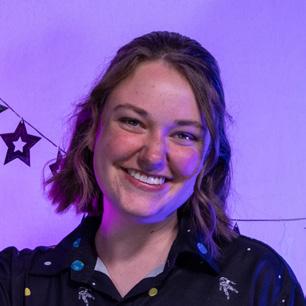
Avery Truman is pursuing environmental studies and geography. When she’s not working in her position as The Utah Statesman managing editor, she enjoys reading and writing science fiction.
— avery.j.truman@usu.edu







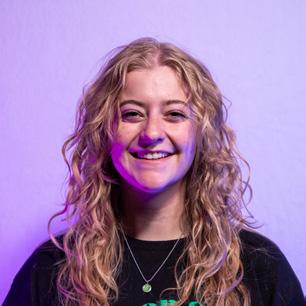







Find community, free refreshments, and more!


April 1
TSC Room 227 and Room 314
Monday - Thursday 8:00am to 7:00pm
The Community Table
Dr. Lucía Sánchez-Gilbert
TSC Room 227 from 12-1pm
Dr. Sánchez-Gilbert is an Assistant Professor of Spanish at Utah State University Her research explores 20th and 21st-century Latin American and Spanish literature and film, focusing on alienation, neoliberalism, and the issues of disability, gender, and sexuality. She is also interested in pedagogical research on Language for Specific Purposes.

Friday 8:00am to 5:00pm What makes YOU stand out from the world?
April 8


The Community Table International Friends Program
TSC Room 227 from 12-1pm
IFP, aims to bridge cultures, build relationships, and create a welcoming environment for international students at Utah State University. Started: Purpose: 2004, celebrated every April To foster community and belonging.


